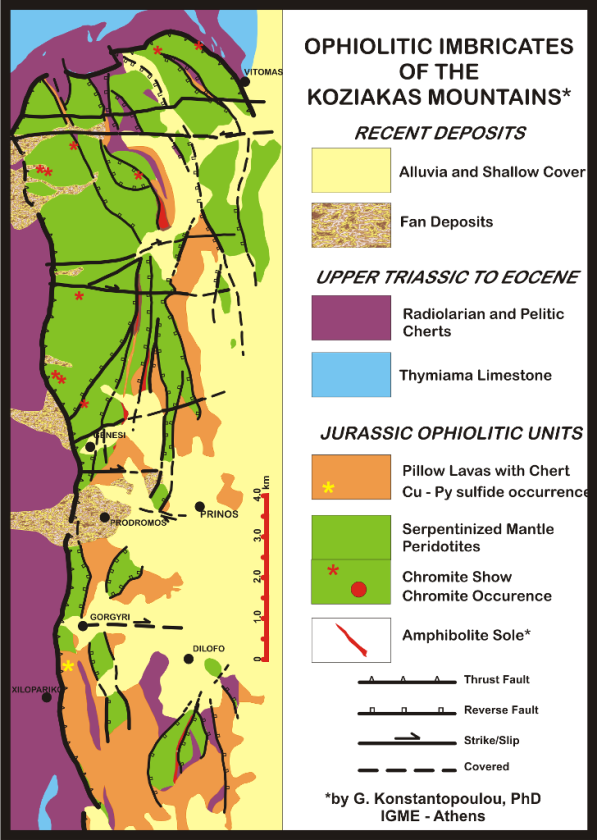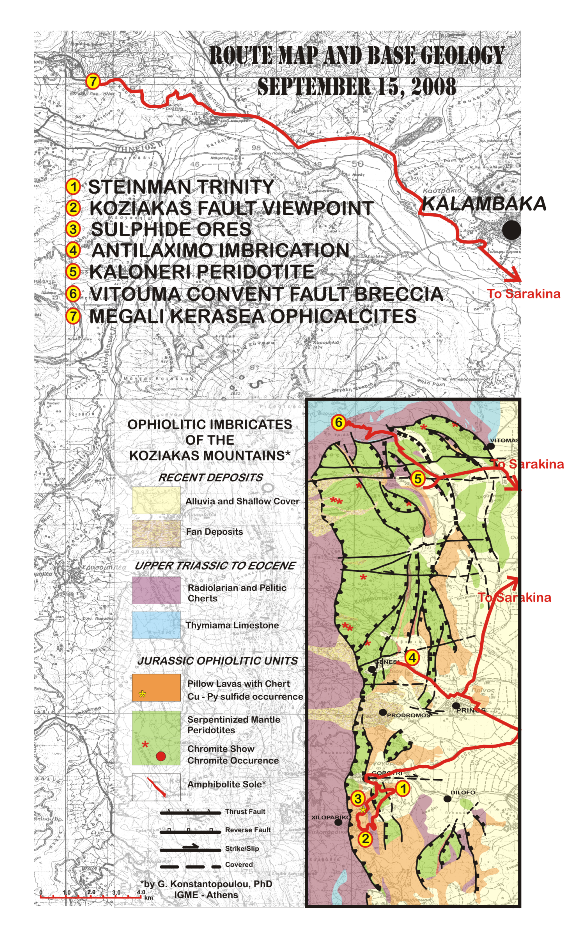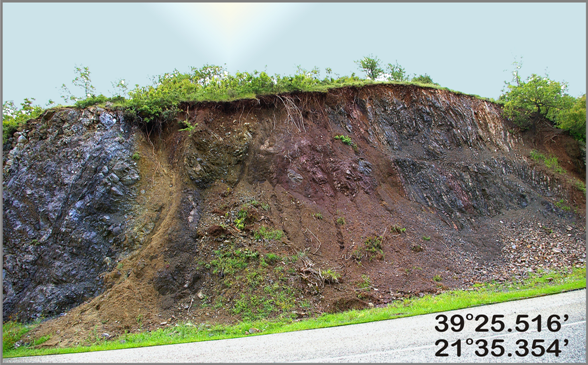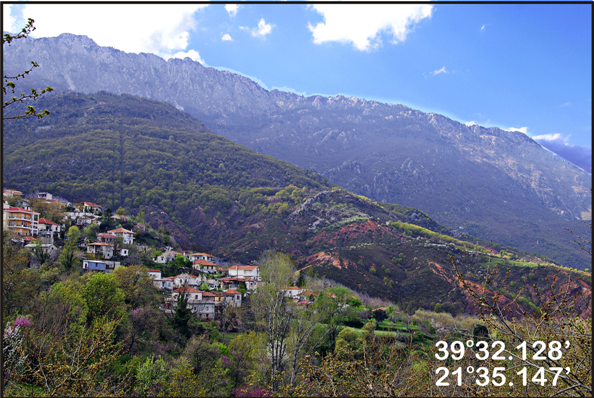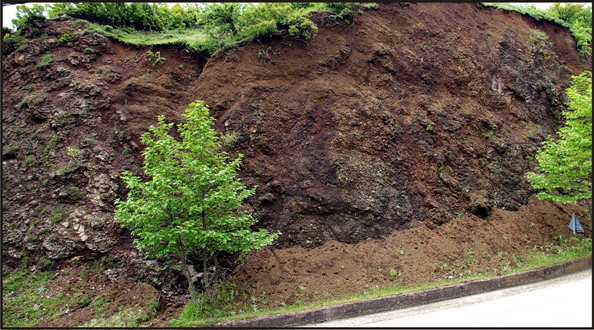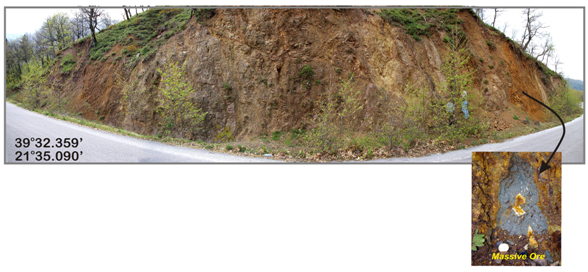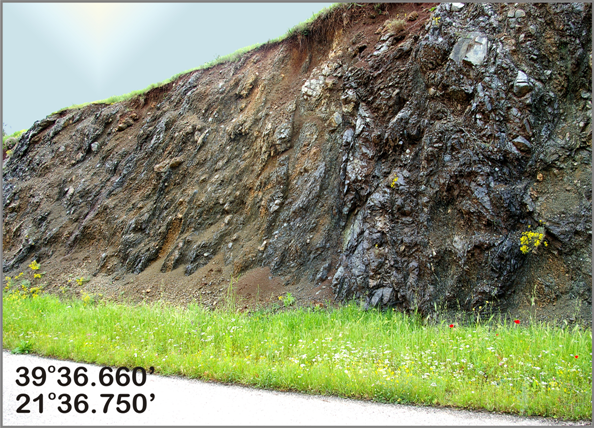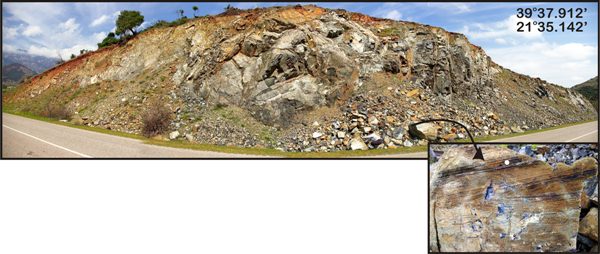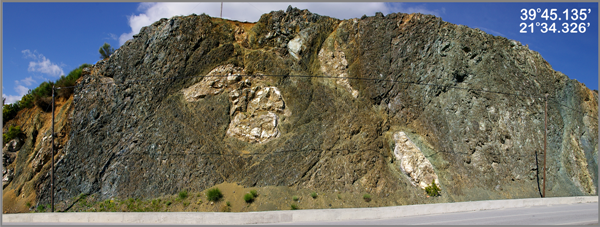Day 1 -THE KOZIAKAS OPHIOLITE
The Koziakas mountain range is a composite stack of nappes which occur in the following order, bottom to top:
Cretaceous limestone and flysch unit
Triassic-Jurassic limestone-chert association
Sub-ophiolitic Mélange unit
Metamorphic sole unit
Mantle tectonite unit
Lava unit
The latter two units are collectively referred to as the Koziakas ophiolite, although the sequence is far from complete, following the classical Penrose conference definition. Magma-chamber rocks are virtually absent and the same holds true for a well-developed sheeted-dyke complex. In detail, the picture is much more intricate.
The sub-ophiolitic Mélange unit is a chaotic mix of lithologies, mainly peridotites, lavas, cherts (i.e. typical Steinmann's Trinity) and limestones, the clasts of which are set in a mudstone-siltstone matrix.
The Metamorphic sole unit is primarily composed of amphibolites with sparse metapelite intercalations.
The Mantle tectonite unit comprises both spinel-harzburgite and spinel-lherzolite with locally important plagioclase lherzolite. Dunite bodies occur in places. These rock types are cut by gabbroic-doleritic dykes but also small trondhjemitic bodies.
The Lava unit encompasses both massive and pillow lavas, usually in that order towards the top, occasionally capped by manganiferous cherts. There is ample evidence for hydrothermal circulation within the lava pile and sites of fluid discharge with deposition of sulphide ore are locally observed.
The only radiometric ages available for the Koziakas massif are those of the amphibolites from the metamorphic sole (161±1 and 174±3 Ma; K-Ar on hornblende) that constrain emplacement by Middle Jurassic. The igneous age of the ophiolitic and sub-ophiolitic rocks remains as yet indeterminate.
Calculations for the sole amphibolites yield peak P-T conditions of 7.1±0.9 Kb at 652±38°C. Such pressures are equivalent to a 24 Km-thick oceanic crust. It is therefore suggested that obduction occurred along a high-T subduction zone, similarly to the Oman ophiolite case. The heat that drove metamorphism was supplied by the overriding ophiolitic mantle peridotites.
Mantle peridotites yielded temperatures of two-pyroxene equilibration of 980±70°C for a nominal pressure of 5 Kb. Olivine-spinel equilibration temperatures average at 700±50°C. Mantle oxygen fugacity conditions showed a significant difference between lherzolite and harzburgite: lherzolites are considerably more reduced than harzburgites (ΔlogfO2 [re: QFM]: 0.20±0.30 vs. 1.00±0.30 respectively), suggesting lherzolite melting at deeper, nearly asthenospheric conditions, and harzburgite melting in shallower, oxidizing conditions, such as present in supra-subduction zone setting. Oxygen fugacity conditions for the plagioclase lherzolites are 1.00±0.50 log units above the QFM buffer, implying formation by melt impregnation at crustal levels (at the Moho). Partial melting estimated by spinel chemistry are about 11% for the lherzolites (13% for the plagioclase lherzolites) and 17% for the harzburgites.
Lava geochemistries represent diverse magmas and geotectonic settings. Lava blocks within the Mélange are typical within-plate (i.e. OIB to E-MORB) affinity, with melting predominantly within the stability field of spinel, and less commonly, of garnet. Basalts and basaltic andesites dominate, but trachytes have also been found. These lavas resemble the Permo-Triassic, rift-related, plume activity that preceded Neotethyan ophiolite generation in the region, especially the Mamonia complex of SW Cyprus. Lavas in the ophiolitic imbricates fall into two groups: back-arc basin basalts and boninites. The latter occur exclusively as dikes cross-cutting other lithologies,signifying the final supra-subduction zone stage before oceanic lithosphere obduction.
Stop 1: Koziakas Ophiolite - Steinmann Trinity
WHAT IS AN OPHIOLITE?
Let us start with an exceptional roadcut that exposes an entire Steinmann’s Trinity: serpentine, lavas, and cherts cropping out within a twenty-meter distance. It is not that easy to make out the imbricated contacts. This stop is a reminder that an ophiolite is not a single rock type, but an assemblage of rock types derived from ocean lithosphere.
The roadcut section is representative of the tectonically-thinned imbricated Koziakas ophiolite. Where are the cumulates, the gabbros, the sheeted dikes? Question to consider: have these units been tectonically removed, or were they never present at all?
Stop 2: Koziakas Ophiolite - Fault Viewpoint
UP AGAINST THE WALL
From the viewpoint overlooking Xilopariko Village, towards the NW, the high ridge of the Koziakas Range consists of Jurassic limestone including imbricates of Triassic red limestones with chert layers: the steep relief gives the impression of a wall bordering this southern extension of the MHT. Further down slope, resistant limestone imbricates protrude from a matrix of Jurassic schistose dark clays, mudstones, and chert. The faulting of the ophiolite imbricate group against the clays and limestones is visible just beyond and below the village. An imbricate of highly sheared ophiolitic pillow lavas crops out across the road from the viewpoint.
Consider: How much imbrication affected the ophiolite while faulted against the Koziakas limestones, and how much before?
Stop 3: Koziakas Ophiolite - Sulphide Ores
HYDROTHERMAL ZONES
Sulphide mineralization here is typical of that found in ophiolitic lavas worldwide, and includes disseminated pyrite and pyrite-arsenopyrite-chalcopyrite (rare) concentrated in narrow channels, including clots of massive ore, within pillow lavas. Hyaloclastic and glauconitic sediments occur between sheared pillows. The imbricated outcrop may contain several hydrothermal channels, or tectonic repetitions of one mineralization pipe. These pipes may give a crude directionality within the sheared pillows.
Consider: No magmatic chamber cumulates or gabbros are exposed locally, and are rare in Koziakas. Does the existence of these hydrothermal pipes imply the existence of a cumulate section that hasn’t been preserved?
Stop 4: Koziakas Ophiolite - Antilaximo Imbrication
WHICH WAY DID IT GO?
This roadcut exposes an imbricate of serpentinite that includes a rather significant fault zone on its western margin. This fault zone may be typical of those which accompanied imbricate emplacement onto the Koziakas limestone, but may also record movements coincidental with older nappe formation within the ophiolite such as undergone in the Othris ophiolite, and possibly original deformation accompanying brittle-field slab emplacement. The serpentinite is folded to the west of the outcrop. Pillow lavas are again exposed about 50 meters further.
Consider: The relative dating of structures are important to understanding all the deformation undergone by the Pindos Basin ophiolites.
Stop 5: Koziakas Ophiolite - Kaloneri Peridotite
OLDER PERIDOTITE DEFORMATION
Imbrication within this exposure of harzburgite indicates an apparent eastern topping direction. The harzburgite contains a pervasive cataclastic fabric, and is the most accessible locality of its type. Elsewhere in Othris and the Pindos, areas of harzburgite and lherzolite in excess of several km area are cataclastites, and represent the final ductile motions of the slab. A fallen block at this locality (inset) displays folding, and even appears to be developing an axial planar foliation. Folding can be defined by analyses of foliations, but the folds themselves are rarely so well discerned in monochromatic peridotite.
Consider: While tempting, we must consider all the rotations undergone by the imbricates before we ascribe a ductile kinematic sense to the Koziakas ophiolite.
Stop 6: Koziakas Ophiolite - Vitouma Convent
OPHIOLITES ALONG FOR THE RIDE
This garden wall at the Vitouma Convent (left photo) is built upon a fault imbricate of Koziakas Limestone and Jurassic sediments against the ophiolite. This fault block is bordered to the west by well-broken chert fragments. Fault breccia (right photo) incorporates predominately ophiolitic clasts within a carbonate matrix. The clasts define a strong orientation (middle photo) that appears parallel to “mega-slickensides” in the upper part of the outcrop. Roadcuts below the convent include ophiolitic lavas and serpentinite fragments as well a a rare imbricate of upper level cumulate gabbro.
Consider: The youngest formations involved in this fault system appear to be Jurassic. MHT tectonism begins during the early Eocene. What is the date of this fault system, and what went on between the Jurassic and the Eocene?
Stop 7: Pindos Ophiolite - Megalo Kerasea Ophicalcites
This tectonic melange crops out along strike of the Pelagonian - Ophiolite margin exposed along the Aliakmon River 20 km to the east, and the magnetically defined continuation of the Pelagonian-ophiolite margin beneath the Mesohellenic sediments. Imbricates are essentially serpentinite with highly deformed lavas and included pods of carbonate (white, age unknown). The kinematic sense varies from Koziakas, and the outcrop can be considered as a “hinge” between Koziakas and the Pindos ophiolites.
Consider: If this is a continuation of Vourinos - Pelagonian margin, could this represent the remnant of an ancient transform?
